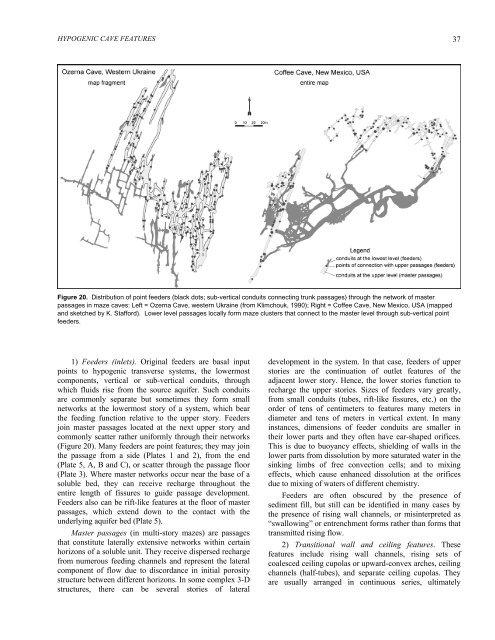Download PDF - Speleogenesis
Download PDF - Speleogenesis
Download PDF - Speleogenesis
Create successful ePaper yourself
Turn your PDF publications into a flip-book with our unique Google optimized e-Paper software.
HYPOGENIC CAVE FEATURES<br />
Figure 20. Distribution of point feeders (black dots; sub-vertical conduits connecting trunk passages) through the network of master<br />
passages in maze caves: Left = Ozerna Cave, western Ukraine (from Klimchouk, 1990); Right = Coffee Cave, New Mexico, USA (mapped<br />
and sketched by K. Stafford). Lower level passages locally form maze clusters that connect to the master level through sub-vertical point<br />
feeders.<br />
1) Feeders (inlets). Original feeders are basal input<br />
points to hypogenic transverse systems, the lowermost<br />
components, vertical or sub-vertical conduits, through<br />
which fluids rise from the source aquifer. Such conduits<br />
are commonly separate but sometimes they form small<br />
networks at the lowermost story of a system, which bear<br />
the feeding function relative to the upper story. Feeders<br />
join master passages located at the next upper story and<br />
commonly scatter rather uniformly through their networks<br />
(Figure 20). Many feeders are point features; they may join<br />
the passage from a side (Plates 1 and 2), from the end<br />
(Plate 5, A, B and C), or scatter through the passage floor<br />
(Plate 3). Where master networks occur near the base of a<br />
soluble bed, they can receive recharge throughout the<br />
entire length of fissures to guide passage development.<br />
Feeders also can be rift-like features at the floor of master<br />
passages, which extend down to the contact with the<br />
underlying aquifer bed (Plate 5).<br />
Master passages (in multi-story mazes) are passages<br />
that constitute laterally extensive networks within certain<br />
horizons of a soluble unit. They receive dispersed recharge<br />
from numerous feeding channels and represent the lateral<br />
component of flow due to discordance in initial porosity<br />
structure between different horizons. In some complex 3-D<br />
structures, there can be several stories of lateral<br />
development in the system. In that case, feeders of upper<br />
stories are the continuation of outlet features of the<br />
adjacent lower story. Hence, the lower stories function to<br />
recharge the upper stories. Sizes of feeders vary greatly,<br />
from small conduits (tubes, rift-like fissures, etc.) on the<br />
order of tens of centimeters to features many meters in<br />
diameter and tens of meters in vertical extent. In many<br />
instances, dimensions of feeder conduits are smaller in<br />
their lower parts and they often have ear-shaped orifices.<br />
This is due to buoyancy effects, shielding of walls in the<br />
lower parts from dissolution by more saturated water in the<br />
sinking limbs of free convection cells; and to mixing<br />
effects, which cause enhanced dissolution at the orifices<br />
due to mixing of waters of different chemistry.<br />
Feeders are often obscured by the presence of<br />
sediment fill, but still can be identified in many cases by<br />
the presence of rising wall channels, or misinterpreted as<br />
“swallowing” or entrenchment forms rather than forms that<br />
transmitted rising flow.<br />
2) Transitional wall and ceiling features. These<br />
features include rising wall channels, rising sets of<br />
coalesced ceiling cupolas or upward-convex arches, ceiling<br />
channels (half-tubes), and separate ceiling cupolas. They<br />
are usually arranged in continuous series, ultimately<br />
37
















